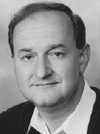|
|
|
 |
ABOUT THE PRESENTER |
Prof. Johnson has been a member of the
Caltech faculty since 1977. He has held the
Ruben Mettler Chair in Engineering and Applied
Science at Caltech since 1988. He was a
visiting professor and Alexander von Humboldt
Distinguished Fellow at the University of
Goettingen, Germany in 1988. His research
accomplishments include the first studies of
superconductivity in metallic glasses, pioneering studies of crystal to
glass transformations in metals and the discovery, characterization,
and development of bulk amorphous metals as engineering materials.
Prof. Johnson is a Fellow of TMS and ASM International and was
elected to the National Academy of Engineering in 2000.
Prof. Johnson is an inventor on over 20 U.S. Patents and the
co-founder of a company, Liquidmetal Technologies Inc., which is
currently pioneering the commercialization of bulk amorphous metals
in engineering applications.
|
Date: Monday, March 15, 2004
Time: 12:30 PM–1:30 PM
Location: Westin Charlotte Hotel
Room: Grand Ballroom A
“Science and Technology of Bulk Amorphous Metals”
 Presented
by: Presented
by:
William L. Johnson, California Institute of Technology
About the topic:
Over the past 15 years, novel families of metal alloys have been
developed which show exceptional resistance to crystallization in
the undercooled liquid state. These “bulk” glass forming alloys can
be processed and formed into three dimensional net shapes in
much the same manner as injection molded plastic. Studies of
flow behavior of viscosity effects (shear thinning), and localization
of flow into shear bands as strain rate increases or temperature
decreases. In the solid amorphous state deformation is controlled
by the formation and propagation of highly localized shear bands
of sub-micron width. Under unconfined mechanical loading, shear
band propagation often results in catastrophic failure and limits the
utility of amorphous metals in structural applications. To suppress
this instability, bulk metallic glass composites have been developed
in which shear bands interact with the alloy microstructure to
stabilize the system against global failure. This results in formation
of shear band patterns, ability to support global plasticity, and
dramatic toughening of the material. Both bulk amorphous metals
and composites are being explored for wide range of engineering
application. Examples will be given in the talk.
|

